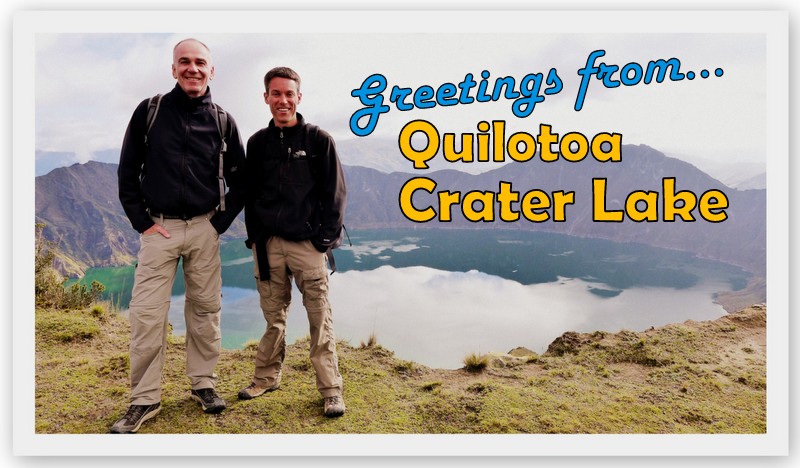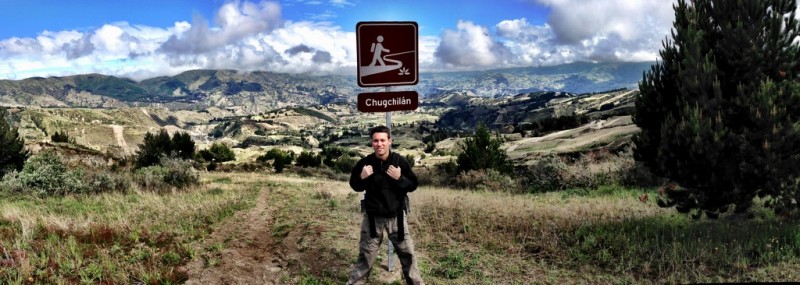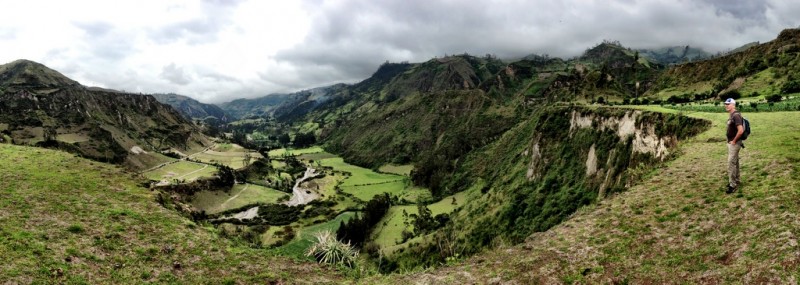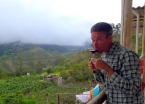
Flipping through the pages of Lonely Planet Ecuador we found a short segment on the Quilotoa Loop, a walking circuit in the central Andean highlands. Eager to leave the tourist-heavy main corridor of the Panamericana highway, this was right up our alley. Offering energetic walks through attractive valleys and nights in isolated Kichwa-speaking villages, this outdoor Ecuadorian excursion reminded us of our gratifying rambles in the UK and Ireland.
So we dumped our heavy stuff in storage at our friendly hostal in Latacunga and set off with light backpacks on a bus bound to Zumbahua. There we found a large crowd awaiting the appearance of Rafael Correa, the socialist president campaigning for his third term.
He’s wildly popular among Ecuador’s indigenous voters: he learned Kichwa (the dominant local language) and has systematically backed strong social programs and public works since he took office in 2007. Fortunately there are sufficient funds to implement these changes since the new constitution guarantees that 85% of proceeds from Ecuadorian resources stay in the country (rather than 15% previously) – much to the chagrin of large multinational companies.
Correa is part of a growing group of popular and pragmatic leftist leaders taking root in Latin America in the last decade, known as the Pink Tide, which rejects the “Washington consensus” policies of unchecked open markets and rampant privatization. Widely expected to win by a landslide, Correa is already the longest-serving Ecuadorian president in more than a century. The current political and economic stability offers enormous hope and optimism for a large part of previously disenfranchised Ecuadorians.

Our first stop was in Quilotoa, a settlement on the rim of Volcán Quilotoa with its stunning turquoise crater lake. We spent the night with other walkers from Germany, Australia, the United Kingdom and Brazil, sharing a hearty family-style meal. We love these kinds of hostales where meeting fellow travelers is easy and conversations flow breezily. It was chilly on the rim at nearly 4000 m (13,000 ft) but the camaraderie warmed our hearts.
Greeted with sunshine the next morning, we explored the lake and walked along the rim towards Chugchilán. All the small villages along the route have somewhat tongue-tricky names (such as Isinliví and Saquisilí) so we found it easier to refer to them by first letter (i.e. “I-town” and “S-town”).
All the hostales provide handy maps and route descriptions and the trail is normally well signposted so navigation is rarely a problem. But soon after leaving Quilotoa we were already unsure of the (signless) turnoff so took the first trail that seemed likely. Soon we were approached by every farmer we passed who offered to guide us “back” to the official trail. We did seem a bit misplaced so we agreed to have a chatty local lady named María show us the way for a couple dollars.
María led us through potato fields and pointed out sights of interest and within five minutes we were back on the (well-signposted) trail. Something told us one of the pivotal signs on the rim trail “went missing” thanks perhaps to these local farmers oh-so-eager to help us out! Our “savior” – she grinned broadly when I called her “Santa” María – did provide some reassurance and enjoyable contact with a local so we didn’t mind the minor kerfuffle.
Back on track, we continued through small villages with waving schoolchildren and green valleys dotted with vegetable patches and dairy farms. We spent the night in cozy Chugchilán (“C-town”) in the welcoming Hostal Mama Hilda, sharing another tasty and talkative meal with the other guests. After dinner the gregarious resident cat Felipe purred on our laps as we relaxed and sipped beer beside the wood-burning stove.
It rained all night, common for the season. Miraculously the skies cleared by morning so we started off along the glistening trail in high spirits. The day’s superb valley walk took us though more tiny villages with just a smattering of houses. We listened to the babbling waters of rivers and waterfalls, encountered four-legged friends, and took in the splendid vistas as we ascended out of the valley into Isinliví village.
Two friendly canines started following us everywhere in the village so we asked the owner about them. She testily answered they weren’t from I-town and insinuated that we walkers intentionally “take” the dogs with us. Village dogs tend to follow walkers from one town to the next despite our best efforts to shoo them off. This irritates the locals who must arrange with truck drivers to get their “abducted” dogs delivered safely home – pet swapping is big business in the area! Paul and I just chuckled about this – the problem could easily be avoided if owners just trained or leashed their pets.
Public transport is really limited which is one of the reasons the region is so refreshingly untouristed. To leave I-town we had two options: a 3 AM bus – no way José! – or the milk truck that left after breakfast. So we hopped in the back of the truck with other locals as the driver stopped every now and then to pick up fresh milk from the dairy farmers along the way – transport with a uniquely local perspective.
It was a memorable ride! The glorious morning served up sunny skies and clear views as far as the eye could see –we caught rare glimpses of the Cotopaxi and Los Illimanis volcanoes which are normally well hidden by clouds this time of year. Along with vats of steaming milk, we were safely delivered back to civilization.
Our three days on the Quilotoa trails were marvelous. There’s nothing like stretching one’s legs in the blessed greenery of another country. The weather was superb, the charming indigenous villages a delight, and everyone we met – travelers, locals, and furry creatures alike – welcomed us with open hearts. Walking is still my favorite way to travel.
The Quilotoa Loop? Two HUGE thumbs up!

















I posted a comment but I don’t see it. At any rate thank you for the stunning pictures of serenity, splendor, walking, transportation. (what’s a milk truck? Reminds me of my childhood.) Love, Mom
Hey Mom, I’m glad the post did the walk some justice, it’s simply hard to put an experience like that to words. BTW the milk truck makes the rounds to the local dairy farms and picks up the fresh milk, one milk maid was still milking her cow as we pulled up… it was quite an experience!
Yes…. That walk was certainly a crowd pleaser and should not be missed. Now if we can only figure out a way to go get Filipe and bring him back home with us …. what an awesome cat!
Felipe would be a handful… plus he’d need to learn English if he came home with us!